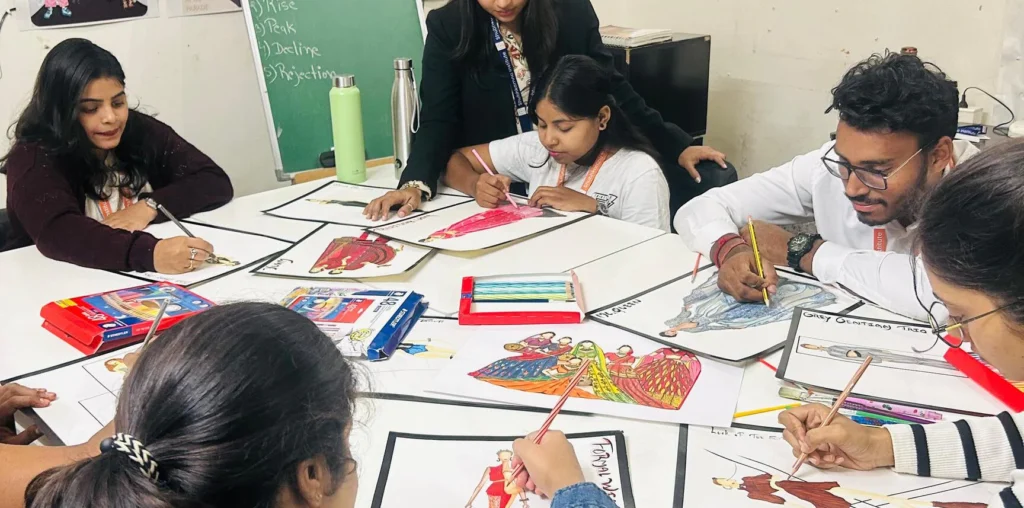The fashion industry is dynamic, competitive, and ever-evolving. Aspiring designers need the right education and skills to make a mark in this glamorous yet demanding field. One of the first decisions to make when stepping into the world of fashion is choosing between an Online or Offline Fashion Designing Course. But which option is better?
In this blog, we at Edu Brain explore the key differences, advantages, and limitations of both learning formats to help you make an informed decision that aligns with your goals.
Understanding the Basics: What is a Fashion Designing Course?
A Fashion Designing Course equips students with the technical skills, artistic insights, and industry knowledge required to create clothing, accessories, and trends. From learning about fabrics, pattern making, and stitching to understanding fashion trends and brand development, a well-rounded Fashion Designing Course lays the foundation for a successful career.
The Rise of Online Fashion Designing Courses
With digital transformation reaching every industry, education has also embraced online learning. Online Fashion Designing Courses have seen a surge in popularity, offering flexibility and accessibility to students from all corners of the world.
Pros of Online Courses:
- Flexibility: Learn at your own pace and schedule.
- Accessibility: Students from remote locations can access quality education without relocating.
- Cost-Effective: No commuting or accommodation costs; often more affordable than offline options.
- Global Exposure: Many online platforms bring instructors from around the world, providing a broader perspective.
Cons of Online Courses:
- Limited Hands-On Experience: Fashion is a practical field, and virtual learning can sometimes lack the tactile experience.
- Need for Self-Discipline: Without a structured schedule, it’s easy to lose focus or fall behind.
- Lack of Peer Interaction: Collaborative creativity is a big part of fashion; online learning may not offer the same level of interaction.
Offline Fashion Designing Courses – The Traditional Route
Offline or classroom-based Fashion Designing Courses have been the backbone of fashion education for decades. Institutes offer comprehensive curricula with direct access to studios, labs, and industry-standard equipment.
Pros of Offline Courses:
- Practical Learning: Access to sewing machines, materials, and physical mentorship enhances skill development.
- Peer Collaboration: Group assignments, peer reviews, and on-campus networking build communication and team skills.
- Live Feedback: Immediate guidance from instructors can refine design skills and reduce learning curves.
- Fashion Events & Internships: Many offline institutes have tie-ups with fashion shows and companies, facilitating real-world exposure.
Cons of Offline Courses:
- Less Flexibility: Fixed schedules may not be suitable for working professionals or students with other commitments.
- Higher Costs: Tuition fees, travel, and accommodation can make offline learning more expensive.
- Geographical Limitations: Quality institutes may not be available in every city.
Comparing Online vs Offline Fashion Designing Courses
| Criteria | Online Courses | Offline Courses |
|---|---|---|
| Flexibility | High | Low |
| Cost | Generally Lower | Generally Higher |
| Practical Experience | Limited | Extensive |
| Peer Interaction | Virtual Only | Face-to-Face |
| Industry Exposure | Variable | High (through fashion shows, internships) |
| Accessibility | Accessible Anywhere | Limited to Location |
Who Should Choose an Online Fashion Designing Course?
An online Fashion Designing Course is ideal for:
- Working professionals looking to shift careers or upskill.
- Students in remote areas without access to fashion institutes.
- Individuals seeking flexible learning schedules.
- Budget-conscious learners who still want quality education.
Platforms like Edu Brain offer comprehensive online Fashion Designing Courses that blend video lectures, live workshops, and design assignments with expert mentorship. Students can build strong foundational knowledge from the comfort of their homes.
Who Should Choose an Offline Fashion Designing Course?
An offline Fashion Designing Course is perfect for:
- School graduates aiming for a full-time design career.
- Individuals who prefer hands-on learning and in-person mentoring.
- Students looking to immerse themselves in the fashion ecosystem.
- Creatives who thrive in collaborative, studio-based environments.
Edu Brain’s offline institutes provide studio training, expert faculty, and access to fashion shows, giving students real-world design exposure and portfolio-building opportunities.
Hybrid Learning: The Best of Both Worlds?
Some institutions, including Edu Brain, now offer hybrid Fashion Designing Courses, combining the flexibility of online learning with periodic in-person sessions. This model balances theory and practice, ideal for modern learners.
Final Verdict: Which is Better?
There is no one-size-fits-all answer. Choosing between an online and offline Fashion Designing Course depends on your lifestyle, goals, learning preferences, and budget.
Go for an Online Fashion Designing Course if:
- You need flexibility and self-paced learning.
- You’re comfortable with digital tools and virtual assignments.
- You’re balancing other personal or professional responsibilities.
Choose an Offline Fashion Designing Course if:
- You value face-to-face mentoring and practical training.
- You’re beginning your career and want full-time immersion.
- You seek networking and real-world opportunities.
At Edu Brain, we are committed to providing the best of both worlds—whether you choose to learn online or on campus. Our mission is to nurture future designers with creativity, professionalism, and global standards.
Ready to Start Your Journey?
Whether you’re just beginning or looking to sharpen your skills, Edu Brain offers the right Fashion Designing Course tailored to your needs. Our expert faculty, industry partnerships, and learner-focused approach ensure that you are industry-ready.


